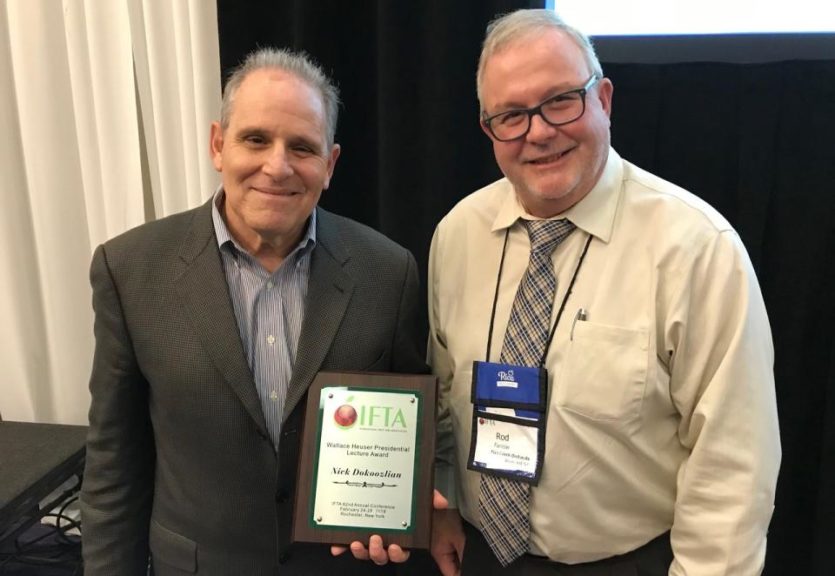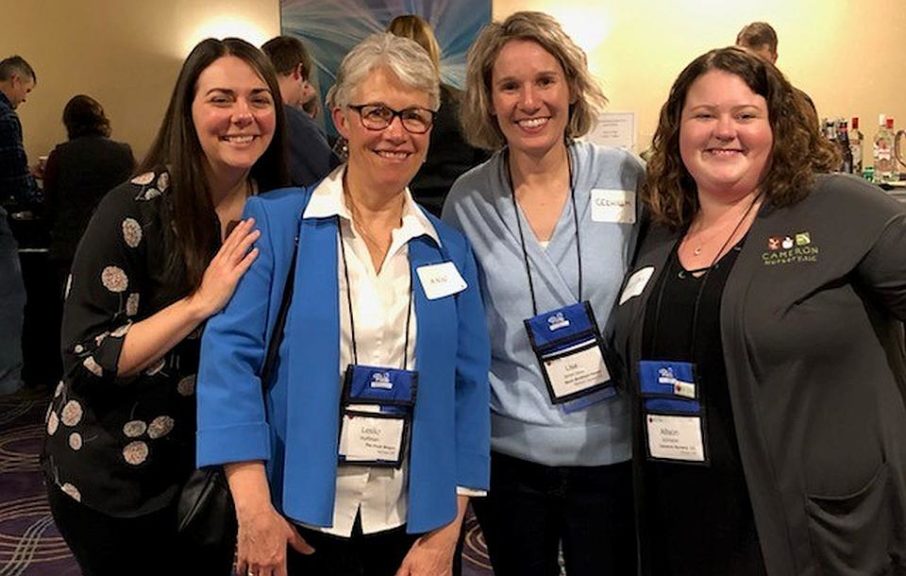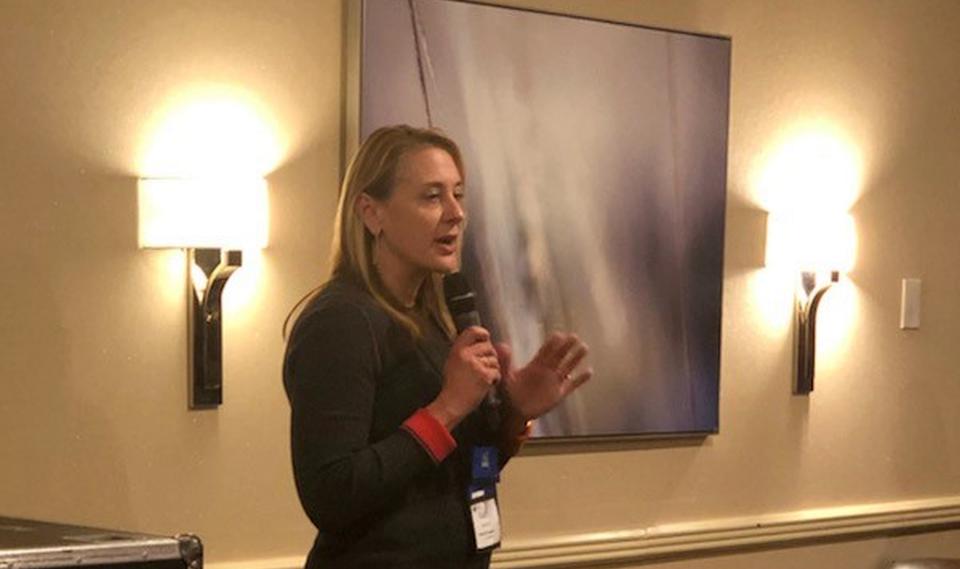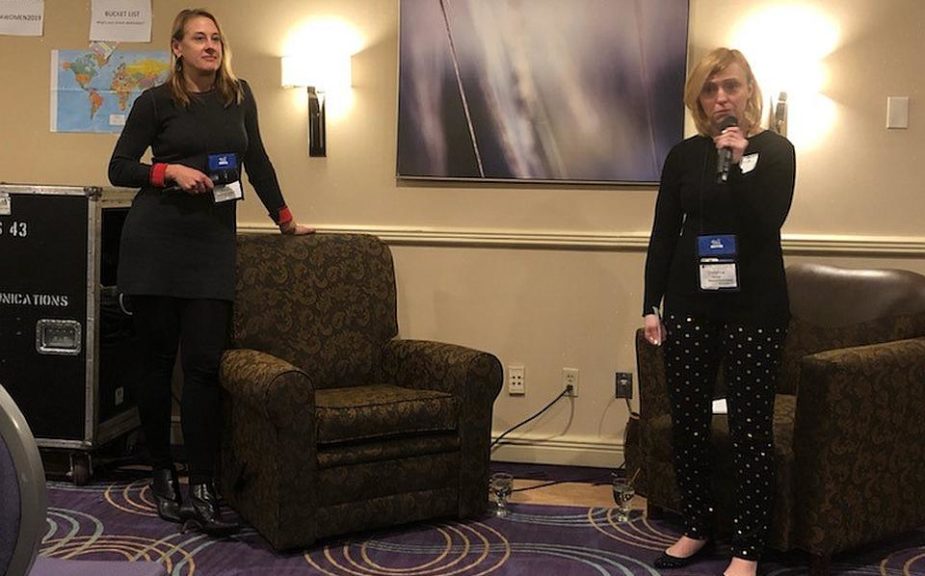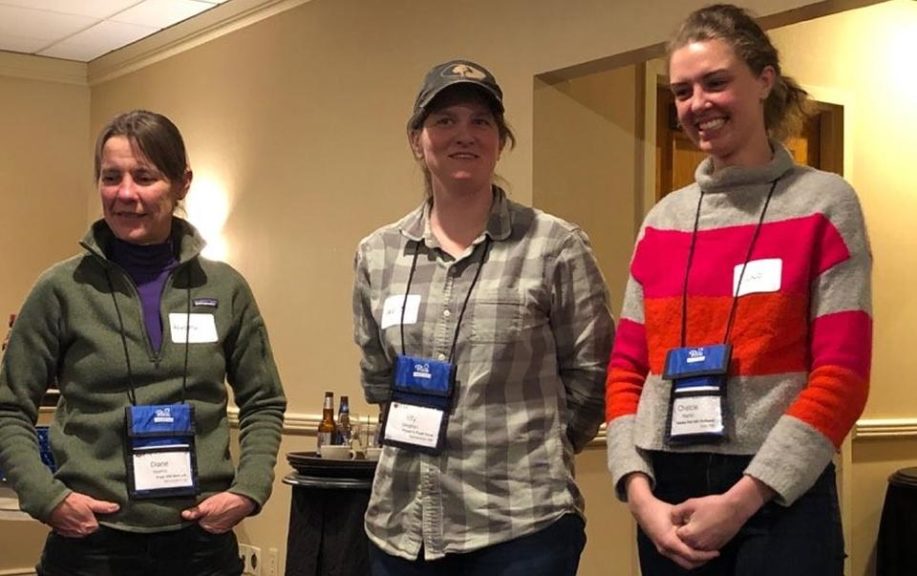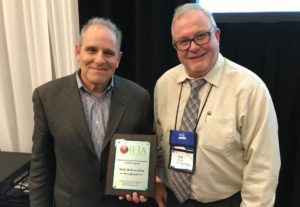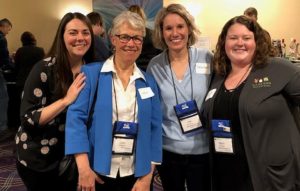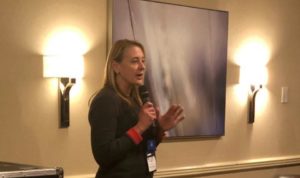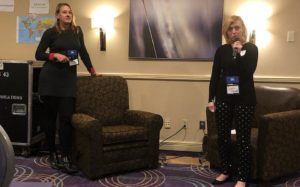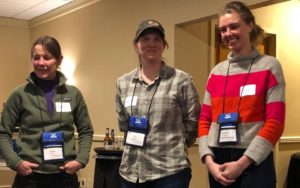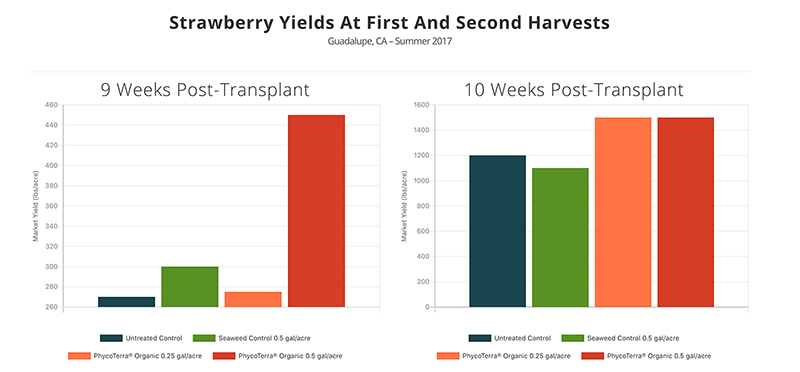What Do Vineyards, Irrigation, Nurseries, and New Technology Have in Common?
Water is at the heart of so many things when it comes to tree fruit production. And while many growers in western New York still don’t have irrigation systems in their orchards, Alan Lakso of Cornell University has spent years helping growers understand the relationship between irrigation and their trees’ production.
One challenge, as Lakso admits to growers: “It’s never average, it’s either a drought or a flood.”
But, he notes that New York growers — without irrigation — can have more drought stress than growers in Washington. Which is remarkable, when you think about it, as the average annual rainfall is three to four times greater. He says irrigation is an important and crucial need for growers in the East because “we really can’t take anything that limits growth of large fruit.”
Lakso began looking to apple trees’ soil-water capacity, which he equates to a bank account. And, as dwarfing rootstocks are planted, their low root density complicates any analysis of soil-water uptake. Because, as Lakso explains, the root structures of high-density orchards are tiny vessels. That makes taking up water like “trying to suck through a tiny straw.”
Ideally, growers would maintain good water status throughout the growing season. Eventually, this led to Lakso’s collaboration with scientists to develop a microtensiometer, essentially to rid researchers from having to lug around a pressure bomb, and to give minute-by-minute measurement of a tree’s stem-water stress. It’s implanted in the stem of a plant, which was easier because “we could never figure out where the roots were,” Lakso quips.
Irrigation mapping was also a major part of how E&J Gallo Winery incorporated new and existing technologies into a useful measurement of plant stress. Nick Dokoozlian, Vice President of Viticulture, Chemistry, and Enology for E&J Gallo Winery presented the Wallace Heuser Presidential Lecture. While many growers may be wondering what on earth a viticulturalist would impart to a bunch of tree fruit growers, Dokoozlian shared how E&J Gallo incorporates technology in their operation, especially when it comes to irrigation.
While acknowledging “it doesn’t take a whole lot to grow grapes in California,” Dokoozlian tipped his hat to the tree fruit industry for the ability to incorporate new varieties with improvements in quality and taste experience. In the wine grape industry, lack of consumer and winemaker acceptance of alternative varieties makes innovation on the variety side nonexistent.
“We have the same eight varieties that make up 80% of consumption,” he says. “Genetics have been taken out of our hands.”
So, the grape industry is looking to innovate in other ways. One promising technology is yield estimation because today Dokoozlian says precision has improved, with yield maps having an accuracy of about one meter. Seeing the great variability in yields was surprising.
“It opened our eyes to what spatial variability is costing our company,” he says, noting with the analysis his team learned 20% to 40% of the vines were producing below the mean average, and grape quality was also quite variable.
So, Dokoozlian set about to increase yield and net revenue. He and his team worked to build models that would take the data collected above ground and integrate with other vineyard data. Maps and models were created to help the viticulture team understand what’s going on in the vineyards and build parameters for things like soil moisture.
E&J Gallo works with Lansat, which is a large collection of high-resolution satellite images, and it gives 30-40 years of imagery. Dokoozlian says they were able to see block-level imagery. And, from the images they were able to develop a precision irrigation system based on the amount of water needed by each segment – vineyards were broken up into segments based on soil type or other variables for closer management.
With this system, cumulative yields increased by 18% and water use efficiency increased by 20%. This was of course done with a lot of ground-truthing to ensure the mapping and modeling were accurate.
Nursery Panel
Brett Adams of Willow Drive Nursery, Tom Auvil of North American Plants, Cliff Beumel of Sierra Gold Nursery, and Tye Flemming of Helios Nursery participated in an interesting panel on advancements in nursery technologies. While most growers may bemoan the cost of a nursery tree, the representatives of these nurseries say it’s difficult to cut costs when a main driver is labor.
While there’s plenty of places in the tree fruit industry where labor costs are going down thanks to new technologies, “nobody’s out there doing that for nurseries,” Adams says.
Beumel agrees, saying it’s also finding people to do the job. It’s difficult to automate in-field tasks and Sierra Gold has automated what they can in the greenhouse, incorporating a mechanized planter.
Another part of cost, Beumel says, is incorporating the new rootstocks’ desirable genetics. Though for some growers, he says “the genetics outweigh the cost.”
Other challenges such as clean plants, record keeping, scaling production to meet demand, were also addressed.
“[They] will keep you up at night and it will age you,” Beumel says.
But, a lot of those issue comes back to technology.
“We’re going to have 3 to 5 years max with the technology that’s currently out there,” Flemming says, noting there will be an influx of new technologies for nurseries to incorporate.
And, nurseries will need to incorporate databases to precisely track material and ensure it’s clean and virus-free. Auvil also says nurseries are going to need to come together as new rootstocks and varieties are released.
“We’re all going to need to collaborate to get material in screen houses,” Auvil says. “Not everything out of Prosser (Clean Plant Center Northwest) can be trusted to be true to type.”
Beumel encouraged growers who want to understand the nursery process to ask questions and form a deep relationship with the nursery they’re working with.
Grower Panel
An interesting grower panel included Jason Woodworth of Lamont Fruit Farms, Justin Finkler of Riveridge Produce, Tom Ferri of TK Ferri Orchards, and Tim Welsh of Columbia Fruit Packers. As expected, the answers on motivating staff, reasons for mechanizing, and overall happiness with the performance of the technology were all over the place.
“I just said, ‘Well, we’re not going back,” Ferri says of transitioning to platforms.
Woodworth and Finkler say there was a generational gap, with their younger workers were more accepting. Welsh says it’s a challenge to get workers to use the platforms at harvest.
“After a while, they got used to not being tired,” Finkler says.
Woodworth says it’s also helpful to have a “spark plug” as a supervisor to get workers interested and engaged in using the platforms.
Finkler says the benefit to platforms is to use it for more than one task to get your best return on investment.
Woodworth says the benefit isn’t as easy to quantify and measure, but “you can see it every day” in terms of how workers feel by the end of the day.
Though Welsh says it’s hard to justify the return on investment of a platform, especially if harvest is out of the equation.
“It’s hard to trade a cheap ladder for an expensive platform,” he says.
He also notes that safety was the main driver for the move to platforms. But “since then I’ve had two injuries on platforms and none on ladders.”
Women’s Network Dinner
The main event at the second IFTA Women’s Network Dinner was a live interview with Kaari Stannard, current chair of the U.S. Apple Association Board of Directors and owner of New York Apple Sales. Stannard’s resume in the produce industry is extensive. She’s a graduate of United Fresh Produce Association’s leadership program and a past member of the organization’s grower-shipper board, and she’s also involved with various Produce Marketing Association committees. Stannard is also a partner in Fish Creek Orchards, Pomona Packing, and Lake Ontario Fruit. Stannard is a board member of the USApple Export Council and a past board member of the New York Apple Association.
Stannard was interviewed by me, with a major assist from our engaged audience who asked so many insightful questions. To read a little bit of what was talked about, check out this interview with Stannard and IFTA President Lisa Jenereaux.
Honoring One of the Greats
Prior to the start of the day’s sessions, Past IFTA President Phil Schwallier and current Board Member Wanda Heuser Gale took time to recognize the death of her father, Wallace Heuser.
“He’s been an absolute giant in the industry,” Schwallier says. “Wally was a giant and we’re all standing on his shoulders.”
Schwallier showed some photos of the first IFTA —then Dwarf Fruit Tree Association—meeting in Michigan at Heuser’s family orchard.
“This was our first pruning demo,” he says. “It looks about the same as today.”
Heuser Gale summed up her father’s feelings about IFTA, noting he “was inordinately proud of this organization.”





